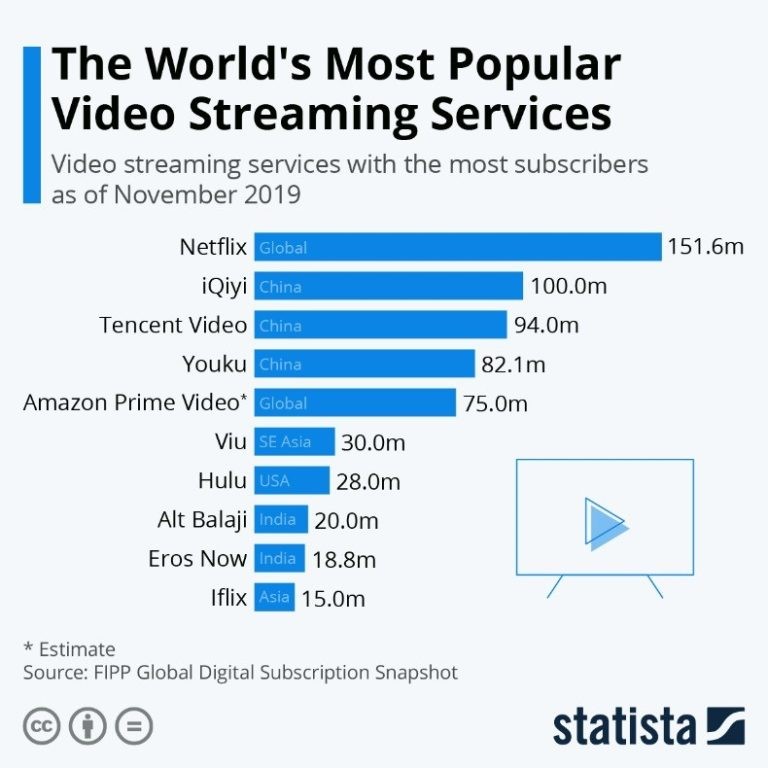“Entertainment is giving people what they want.” – Howard Hawks
Entertainment, in its essence, is the art of captivating and delighting people, whisking them away from the mundane and into a world of imagination and emotion. It comes in various forms, from the tales told around ancient campfires to the dazzling spectacles of modern cinema. Traditionally, we relied on television, radio, and theatres to satiate our thirst for entertainment. However, a new dawn has emerged with the advent of Over-The-Top (OTT) platforms, which deliver a wide array of digital content directly to consumers over the internet, transforming the way we consume content. These platforms, accessible at the tap of a screen, are redefining the entertainment landscape, and their impact is both revolutionary and intriguing. As we project into the future, it is evident that the impact of OTT platforms on the entertainment industry will be profound by 2040.
This essay explores the factors contributing to the rise of OTT platforms, their current significance, and the potential implications they may have on content creation, distribution, consumption, and the traditional media landscape.
The Rise of OTT Platforms: A Historical Context
The landscape of entertainment underwent a remarkable transformation with the rise of Over-The-Top (OTT) platforms, a shift that can be traced back to the early 2000s. This period marked the inception of a new era in content consumption, led by pioneering companies like Netflix, which dared to venture into uncharted territories of streaming content over the internet.
In their initial stages, these OTT platforms focused on a rather modest goal – providing a digital reservoir of older movies and television shows. This innovative approach offered a departure from conventional entertainment delivery methods, introducing the concept of on-demand viewing. No longer were audiences tethered to rigid schedules dictated by traditional television broadcasts or cinema showtimes. Instead, viewers could now delve into a treasure trove of content at their convenience, ushering in a new era of viewer empowerment.
The convenience of on-demand viewing was the first ripple in the pond, setting the stage for an even more profound transformation. As internet infrastructure and connectivity improved, a fertile ground was created for OTT platforms to flourish. With the steady march of technology, consumer preferences began to shift, demanding not only convenience but also diversity and originality in content offerings.
Recognizing this demand, OTT platforms embarked on a journey to reinvent themselves. They swiftly evolved from being mere repositories of nostalgic classics to becoming creators and distributors of original programming. This strategic pivot marked a turning point, shaking the very foundations of traditional broadcast and cable TV models.
Original programming injected fresh life into the realm of entertainment, captivating audiences with narratives that were previously unheard of. As OTT platforms unleashed their creative prowess, they embraced storytelling in all its diverse forms – from gripping dramas and thrilling mysteries to heartwarming comedies and eye-opening documentaries. This creative renaissance shattered the monopoly that traditional media had held for decades, offering a level playing field for both established and emerging storytellers.
The expansion of OTT offerings wasn’t merely a quantitative growth; it represented a qualitative leap. Audiences were no longer limited to a predetermined menu of content; they were handed the reins to an expansive universe where choice and personalization reigned supreme. This revolution ignited a ripple effect across the entertainment industry, influencing content creators, and production studios, and even influencing the very way stories were conceived and told.
Factors Driving the Rise of OTT Platforms

1. Convenience and Personalization: OTT platforms offer unparalleled convenience and personalization. Viewers can access content whenever and wherever they want, catering to their schedules and preferences. The ability to create personalized profiles, curated recommendations, and watchlists has created a more tailored and engaging viewing experience.
2. Content Variety and Original Programming: OTT platforms have invested heavily in producing high-quality original content, ranging from TV series and movies to documentaries and stand-up specials. This commitment to diverse and compelling content has attracted a broader audience and positioned OTT platforms as formidable competitors in the entertainment industry.
3. Global Reach and Accessibility: The global accessibility of OTT platforms has broken down geographical barriers, enabling content creators to reach audiences worldwide without the limitations of traditional distribution channels. This has fostered cross-cultural exchange and enriched content diversity.
4. Technological Advancements: Advancements in streaming technology, including improved video compression algorithms and faster internet speeds, have facilitated seamless content delivery. This has reduced buffering issues and enhanced the overall user experience, further incentivizing consumers to adopt OTT platforms.
5. Disruption of Traditional Models: OTT platforms have disrupted traditional media models by offering subscription-based and ad-supported options that challenge the conventional pay-TV model. This disruption has prompted traditional media companies to adapt and create their streaming services, intensifying competition within the industry.
The Current Significance of OTT Platforms
As of the present day, OTT platforms have already significantly transformed the entertainment landscape. Major players like Netflix, Amazon Prime Video, Disney+, and Hulu have amassed massive subscriber bases, challenging the dominance of cable and broadcast television. The ability of these platforms to produce critically acclaimed and culturally impactful original content, such as Stranger Things, The Mandalorian” and “The Crown” has further solidified their place in popular culture.
OTT platforms have also revolutionized content consumption habits. Binge-watching, or consuming multiple episodes of a TV series in rapid succession, has become a cultural phenomenon enabled by the release of entire seasons at once. This shift in viewing behaviour has influenced storytelling techniques and narrative structures, as content creators aim to engage audiences over extended periods.
Impact on Content Creation and Distribution
Looking ahead to 2040, the impact of OTT platforms on content creation and distribution will likely be even more pronounced. The ability of these platforms to gather vast amounts of user data and insights will enable content creators to make more informed decisions about the type of content that resonates with audiences. This data-driven approach may lead to more targeted and innovative storytelling, resulting in a diverse range of content that caters to various tastes and preferences.
Additionally, the direct-to-consumer model of OTT platforms eliminates the need for traditional distribution channels, reducing intermediaries and production costs. This may empower independent filmmakers and creators to showcase their work to a global audience, democratizing the content creation process and fostering creativity and diversity.
However, the dominance of OTT platforms could also pose challenges to content diversity. While these platforms have expanded the range of stories being told, there is a risk that certain niche genres or perspectives may be overshadowed by the pursuit of mass appeal. Content algorithms that prioritize popular genres could limit exposure to lesser-known content, potentially hindering the discovery of unique voices.
Changing Consumer Behavior and Expectations
The rise of OTT platforms has fundamentally shifted consumer behaviour and expectations, and this trend is likely to continue. The demand for instant gratification, personalized recommendations, and a seamless viewing experience has set a high standard for the industry. By 2040, we can expect consumers to expect even more immersive and interactive experiences, driven by advancements in virtual reality (VR) and augmented reality (AR) technologies.
Furthermore, the concept of “cord-cutting” – the act of cancelling traditional cable or satellite TV subscriptions in favour of OTT platforms – is projected to become the norm by 2040. As more households transition to streaming services, the traditional TV ecosystem could undergo a profound transformation, leading to changes in advertising models, revenue streams, and the overall content landscape.
Diversified and Tailored Content Creation:
By 2040, OTT platforms will have catalyzed a revolution in content creation. The democratization of production tools and distribution channels will empower a diverse range of creators to showcase their talents on a global stage. The boundaries of storytelling will be pushed, giving rise to narratives that reflect a spectrum of cultures, perspectives, and experiences. Personalization algorithms will refine content recommendations, ensuring that each individual’s entertainment journey is a unique and engaging one.
The Erosion of Traditional Broadcast and Cable TV:
The traditional broadcast and cable TV models, once the stalwarts of entertainment, will be shadows of their former selves. The dominance of OTT platforms will relegate scheduled programming to nostalgia, as audiences demand the freedom to curate their viewing schedules. Live streaming and real-time interaction will bridge the gap between virtual and reality, providing immersive experiences that redefine the concept of “appointment viewing.”
Globalization of Content:
The boundaries of geography will blur as OTT platforms transcend borders. By 2040, audiences around the world will effortlessly access content from diverse cultures, languages, and genres. The exchange of stories and ideas will foster cross-cultural understanding and appreciation, contributing to a more interconnected global society.
Interactive and Immersive Experiences:
The integration of emerging technologies, such as virtual reality (VR) and augmented reality (AR), will elevate entertainment to new heights. Viewers will step into the worlds of their favourite shows and movies, becoming active participants in the storytelling process. Immersive narratives and interactive elements will blur the line between fiction and reality, engaging audiences in ways never before imagined.
Monetization and Industry Dynamics:
The monetization landscape will undergo a profound transformation. Advertising models will evolve as targeted, non-intrusive ads replace traditional commercial breaks. Subscription-based and pay-per-view models will flourish, providing viewers with a plethora of options tailored to their preferences. The traditional “box office” concept will extend beyond theatres, as online premieres and exclusive releases become the norm.
Challenges and Considerations
While the rise of OTT platforms presents numerous opportunities, it also raises important considerations and challenges for the entertainment industry. The proliferation of streaming services could lead to subscription fatigue, where consumers are overwhelmed by the sheer number of available platforms. This may drive some users to piracy or result in a decline in overall revenue for the industry.
Additionally, issues related to data privacy and content moderation will continue to be significant concerns. The collection of user data to improve recommendations and advertising targeting raises questions about the ethical use of personal information. Furthermore, the open nature of online platforms can make it difficult to regulate inappropriate or harmful content, requiring industry stakeholders and policymakers to collaborate on effective solutions.
Conclusion
In conclusion, the rise of OTT platforms has already made a substantial impact on the entertainment industry, and their influence is likely to be even more profound by 2040. The convenience, personalization, and global accessibility of these platforms have transformed content consumption habits and disrupted traditional media models. As we project into the future, we can anticipate further advancements in technology, changes in content creation and distribution, and evolving consumer behaviour and expectations.
While the challenges posed by the rise of OTT platforms should not be overlooked, their potential to democratize content creation, offer diverse narratives, and provide innovative viewing experiences is undeniable. Industry stakeholders, content creators, and policymakers must collaborate to navigate these challenges and harness the full potential of OTT platforms for the benefit of both creators and consumers in the evolving entertainment landscape of 2040.
Blackcoffer Insights 47: Mukti, Sri Venkateswara College, University of Delhi














